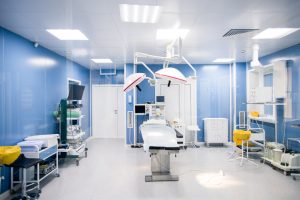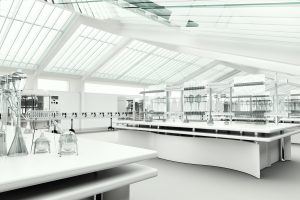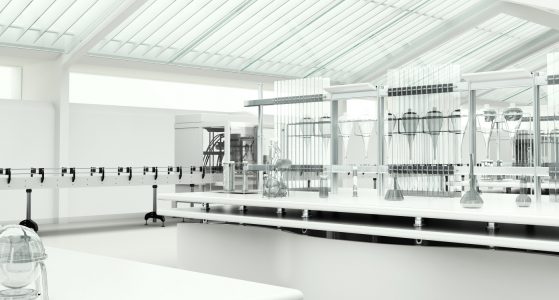Infectious diseases are spread through contaminated surfaces, with some bacteria and viruses living for days on nonporous surfaces. UV light is proven to provide effective surface disinfection, eliminating even drug-resistant super-bugs and novel coronaviruses with high efficacy.
UVC Lamps Provide Surface Disinfection
Cold and flu viruses can remain infectious on surfaces for several hours or even days, depending on the surface, the temperature and humidity of the environment, and the amount of virus deposited on the surface. As documented in the Technical Report, 2020 COVID-19 Coronavirus Ultraviolet Susceptibility, the SARS-CoV-2 virus that causes the COVID-19 respiratory disease, is expected to live on surfaces anywhere from 6 hours to 9 days. Viruses tend to live longer on surfaces that are stainless steel, plastic or similarly hard, nonporous surfaces as opposed to softer surfaces such as fabrics.
Using ultraviolet (UV) light to disinfect surfaces is also called ultraviolet germicidal irradiation, UVGI, and is a method of disinfection proven to be highly effective when administered with adequate dosing from quality UV lamps. Germicidal lamps for disinfection purposes are designed differently than standard fluorescent lamps, engineered to emit wavelengths in the UVC range.
Ultraviolet light emitted from the sun is not visible to the human eye as it has a higher frequency, thus a shorter wavelength, than visible light. UV light ranges from 10 nm (vacuum and extreme UV) to 400 nm, divided mostly into UVA (315-400 nm), UVB (280-315 nm) and UVC (100-280 nm), with UVC being the most effective at disinfection with germicidal properties.
The Many Uses of UVC Surface Disinfection
UVGI has been used as an accepted method of disinfection since the mid-20th century, primarily in medical disinfection applications. UV disinfection has also been an important part of water disinfection applications used in drinking and wastewater treatment facilities worldwide including thousands of UV water treatment plants in Europe and North America. The use of UVC lamps for surface disinfection can be implemented in such a wide range of industries and applications it is difficult to list them all.
Some of the most common and easy to implement uses of UV light for surface disinfection include the following:
Hospitals, Healthcare and Medical Facilities

Preventing the spread of disease in hospitals and healthcare facilities has always been of vital importance. Following a strict disinfection policy that includes the use of UV light for hospital disinfection is proven to provide significant added protection and elimination of up to 99.99% of viruses and bacteria. UVC lamps in hospital disinfection devices include wall-mounted, portable, and UVC robots as well as UVC HVAC air disinfection systems.
UV surface disinfection can benefit nearly every area of a hospital including:
- Patient rooms
- Operating rooms
- Emergency rooms
- Waiting rooms
- Hallways
- Restrooms
- Cafeterias
- Medical devices
Food and Beverage Processing

The use of UVC radiation to treat food products is called food irradiation, which provides many benefits to various food groups including meats, fish, poultry, fruits and vegetables, liquid storage tanks and more. UV surface disinfection also provides many benefits by eliminating viruses and bacteria including E.coli and salmonella in food preparation areas, food handling and storage areas.
UVC germicidal lamps are also beneficial in grocery stores at meat counters and frozen foods sections as they can prevent mold and mildew from building up inside damp, moist freezers.
Restaurants

Restaurants that incorporate UV disinfection systems can maintain a much cleaner environment free from harmful pathogens. UV lamps utilized in commercial kitchens and dining areas help to protect restaurant patrons and staff against the spread of disease and to maintain compliance to health code regulations.
UV lamps in a commercial kitchen hood exhaust also prevent the build-up of grease which reduces the risk of fire and maintains a cleaner kitchen equipment.
Schools
Children of all ages can be super-spreaders of viruses as they are social by nature and may be less likely to perform proper hand hygiene. UVC disinfection lamps can be installed in classrooms, cafeterias, and hallways to help prevent the spread of disease in schools.
Laboratories

Clean rooms, research labs, and university laboratories must maintain a disinfected environment on all lab surfaces and equipment. This is critical in all types of labs, including medical testing, pharmaceutical processes, biotech labs, and bioengineering labs.
By using UV light to disinfect surfaces and equipment such as instruments, safety goggles and other devices, laboratories can help to maintain an environment free from contaminating microorganisms.
Public Transportation
The spread of pathogenic microorganisms in transit vehicles is high due to the close proximity of riders on buses, trains and airplanes. Many riders pass through a subway station and touch the same surfaces. Germs circulating through vehicle AC ventilation systems spread airborne germs. UV lamps are improving safety for the public in various surface disinfection systems such as UVC lamps mounted in buses or UVC robots roaming an airport.
Confirmation of UV Surface Disinfection Effectiveness
Short-wave UVC radiation kills or inactivates harmful microorganisms on surfaces by destroying the nucleic acids and disrupting their DNA, this leaves the cells unable to replicate and renders them harmless. The SARS-CoV-2 virus that causes COVID-19 is a new variant in the beta coronavirus family similar to SARS and MERS, which are both highly susceptible to UV inactivation. A D90 value indicates the level of UV dose required for 90% inactivation as reported in 2020 COVID-19 Coronavirus Ultraviolet Susceptibility, with all known coronaviruses effectively eliminated at 90% within the D90 dosage range of 7 to 241 J/m2 with a mean of 67 J/m2. Two studies indicate the susceptibility of SARS-CoV-2 to an average of 27 J/m2 UV radiation.
Viruses are molecules with DNA that may be encapsulated or naked and cannot replicate without a host. Viruses cannot be treated with antibiotics and require a vaccine. The difference between a virus and bacteria is that bacteria are self-contained with no cell walls and can replicate and survive on their own. UV radiation is also highly effective at eliminating super-bugs and drug-resistant bacteria such as:
- Methicillin-resistant Staphylococcus aureus (MRSA)
- ESBL-producing Escherichia coli (E. coli)
- Vancomycin-resistant Enterococcus faecium (VRE)
- Clostridium difficile
- Multidrug-resistant pseudomonas
- Carbapenemase-resistant Klebsiella pneumoniae (KPC)
Benefits of UV Surface Disinfection
There are many benefits to disinfecting surfaces with UV light in addition to a highly effective kill rate of viruses and bacteria. While surfaces should still be cleaned with manual cleaning methods to ensure a clean surface free from organic compounds upon UV exposure, by adding UV light disinfection to your cleaning regimen, you can ensure a higher level of protection against disease without the use of additional chemicals.
UV radiation on food is highly beneficial in that there is no need to expose food items to chemicals to prevent infestations and foodborne illnesses. UV disinfection is extremely cost-efficient, operating 24/7 with no need for additional labor or maintenance. Surface disinfection is extremely effective and cost-efficient when using high-quality UVC germicidal lamps.
LightSources offers a wide selection of germicidal UVC lamps to perform in nearly any disinfection application involving surfaces, air or water, including:
- Low-pressure mercury germicidal lamps
- Standard output
- High output
- Compact
- Specialty
- Amalgam germicidal lamps
- Spot and pellet technology
- Medium-pressure germicidal lamps
- Ozone lamps
- Electronic ballasts
- Lamp components
LAMP PRODUCT DATA:
UV Germicidal LampsLAMP APPLICATIONS:
UV Germicidal ApplicationsLightSources and affiliated companies, Voltarc and LCD Lighting along with strategic partners, LightTech and Cerlux, represent the leading high-tech designers and manufacturers in the lamp industry today. Our standard lamps and components as well as customized products offer high-quality solutions to meet our partner’s unique needs. Please contact us for more information about our germicidal UVC lamps designed for surface disinfection.


